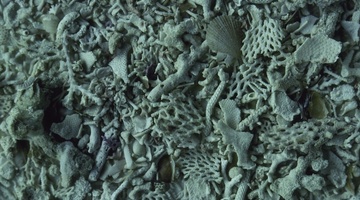Professor Cam Nelson explains how his study of limestones in the King Country region led him to conclude that they were formed in cool temperate environments. At that time, it was believed that all shelf limestones had a tropical origin. Cam’s work was instrumental in developing the temperate cooler water limestone model that now sits alongside the tropical warm water model.
Points of interest
Some of the micrographs and samples shown in this clip:
- Micrographs a and d: – thin section images (x40) of bryozoan-dominated temperate limestone
- Micrograph b: Ōtorohanga limestone thin section showing an abundance of bryozoan and small foraminifera skeletons.
- Sample c: Sediment referred to as ‘bryomol’ – rich in the skeletal remains of bryozoans and molluscs. Dredged from the seafloor off Three Kings Islands to the north of New Zealand.
Transcript
PROFESSOR CAM NELSON
The two main limestones here, the Orahiri limestone and the Ōtorohanga limestone, when I worked on these several decades ago, I could not reconcile the nature of these limestones with what was in the literature of the day. The literature of the day suggested that limestone should all be coral reefs and should’ve all formed in very warm water, tropical water, shallow water. There are no coral reefs in any of these Oligocene limestones – none at all, none in New Zealand in the Oligocene – and that had me worried, and after a while, I realised that limestones could form outside the tropics. These were cooler water, temperate water limestones. They’re the sort of limestones that in fact are forming locally around New Zealand today in our temperate waters.
And so what has developed from a regional, indeed, a New Zealand-wide study is that now we recognise that shallow marine limestones do not have to be the Great Barrier Reef kind of situation. They can also form in cooler temperate waters.
Most corals secrete a skeleton of aragonite, whereas most of the skeletons that contribute to our cooler water limestones tend not to be aragonite secretors – they’re mainly calcite secretors. And calcite’s a rather more stable form of calcium carbonate than is aragonite, so it tends to persist into the rock record that much better. So yes, cool water limestones, one of their characteristics is that they tend to be calcite dominated rather than the tropical limestones, which are very much aragonite dominated.
So in the modern, we can go to cooler seas such as around New Zealand and we can see limestones in the making on the seafloor, and the make-up of their skeletons is exactly what we see in these 20 million year old, 25 million year old limestones. So it’s the skeletal contribution and the principal skeletal contribution of bryozoans, and these are relatively rare in tropical limestones but absolutely abound in these limestones. So the bryozoans which are normally calcite secretors are by far the dominant cool water secretor in these cool water or temperate limestones.
And a very important outcome has been now the worldwide recognition that we are dealing with two types of limestones as end members – a tropical reef-type limestone and model and a more temperate cooler water limestone model, which really has come out of New Zealand studies.
Acknowledgements:
Axel Rosenburg
Dr Roger Grace





